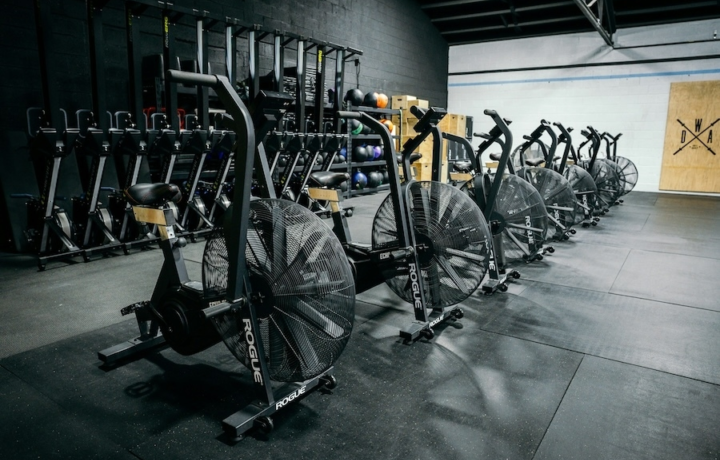Exercise
Dumbbell Lunge

Dumbbell Lunge
How to Perform
- Stand upright with your feet hip-width apart, holding a dumbbell in each hand with arms straight by your sides and palms facing inward.
- Maintain a neutral spine and engage your core as you take a controlled step forward with your right foot, landing heel first.
- Lower your body by bending both knees until your right thigh is parallel to the floor and your left knee hovers just above the ground, forming two 90-degree angles.
- Keep your torso upright throughout the movement, with shoulders pulled back and down away from your ears.
- Exhale as you push through the heel of your front foot to return to the starting position, driving with your front leg's quadriceps and glutes.
- Repeat the movement with your left leg, maintaining even weight distribution through both feet during the lunge.
- Keep your front knee aligned with your second toe and never extending past your toes to protect your knee joint.
- Breathe rhythmically throughout the exercise, inhaling as you lower and exhaling as you push back to standing.
Important information
- Keep your upper body straight and tall throughout the entire movement; avoid leaning forward or backward.
- Make sure your weight is evenly distributed between both feet when in the lunge position for optimal balance and stability.
- If you're new to lunges, start without weights to master proper form before adding dumbbells.
- To increase difficulty, take a longer step forward or hold heavier dumbbells as your strength improves.

Dumbbell Lunge
Exercise Details
Primary Muscles
Muscle Groups
Mechanic
Risk Areas
Built for progress
Take the guesswork out of training
Create personalized AI-powered workout plans that evolve with you. Train smarter, track every rep and keep moving forward, one workout at a time.






The dumbbell lunge stands as a cornerstone exercise in any well-rounded fitness regimen, offering tremendous benefits for those who've moved beyond beginner status. This intermediate movement primarily targets the lower body powerhouse muscles - the glutes, quads, and hamstrings - creating a comprehensive lower body strengthening experience with just one exercise.
When incorporated into bodybuilding routines, the dumbbell lunge excels at sculpting defined quad sweeps, building hamstring density, and developing rounder, stronger glutes. The unilateral nature of this movement addresses muscular imbalances between your left and right sides, promoting symmetrical development that's crucial for aesthetic physique goals.
For those embracing high-intensity interval training (HIIT), dumbbell lunges inject serious metabolic stress when performed with appropriate intensity. The large muscle recruitment creates a significant oxygen demand, elevating your heart rate and maximizing caloric burn both during and after your workout through the EPOC (excess post-exercise oxygen consumption) effect.
Strength enthusiasts particularly appreciate how dumbbell lunges build functional power through a natural human movement pattern. The exercise develops stabilizer muscles throughout the kinetic chain while improving coordination between your upper and lower body. This translates to enhanced performance in everyday activities and other athletic pursuits.
The beauty of the dumbbell lunge lies in its versatility. By adjusting weight, tempo, stance width, or step length, you can manipulate the training stimulus to align with specific goals. This adaptability makes it suitable for various training phases - from volume-focused hypertrophy blocks to heavier strength-building periods.
While challenging, the dumbbell lunge rewards consistent effort with improved lower body aesthetics, enhanced functional strength, and better movement quality. The exercise demands respect for proper form, but offers impressive returns when executed with appropriate technique and integrated strategically into your training program.
FAQ - Dumbbell Lunge
Dumbbell lunges primarily target your quadriceps, hamstrings, and glutes as the main movers. They also engage your calves, core, and lower back as stabilizers, making them an excellent compound exercise for lower body development.
For an easier version, use lighter dumbbells or perform stationary lunges with a shorter stance. To increase difficulty, use heavier weights, try walking lunges, incorporate a deficit (stepping off a platform), or slow down the eccentric (lowering) phase to 3-5 seconds.
The most common mistakes include allowing the front knee to extend past the toes, leaning too far forward at the torso, not stepping far enough forward, and dropping the back knee too hard onto the floor. Keep your torso upright and ensure your front knee stays aligned with your ankle.
Include dumbbell lunges 1-3 times weekly with at least 48 hours between sessions targeting the same muscle groups. They work well as part of a lower-body day or full-body workout, typically performing 3-4 sets of 8-12 reps per leg for hypertrophy goals.
While lunges can be therapeutic for some knee conditions when performed correctly, they may aggravate others. Start with bodyweight lunges to assess comfort, focus on perfect form with moderate ranges of motion, and consider alternatives like split squats if pain persists. Always consult a healthcare provider if you have existing knee problems.








